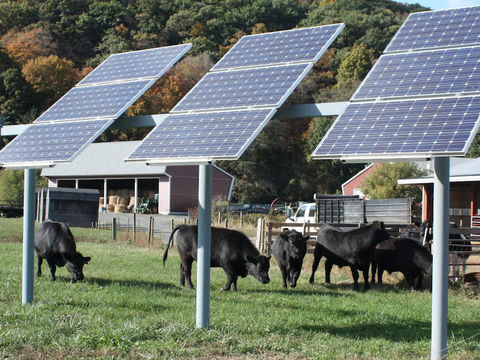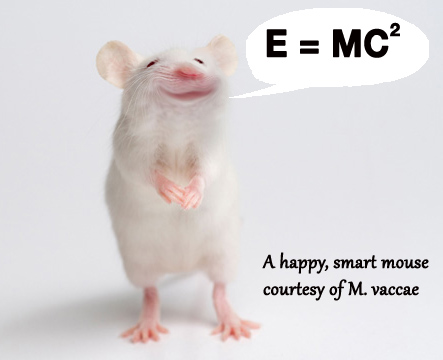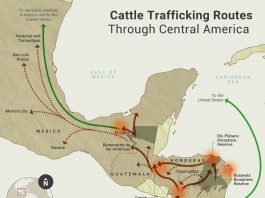
A recent Oregon State University study found that the top three land covers with the greatest solar power producing potential are croplands, grasslands and wetlands. The study, published in the journal Scientific Reports, says that if less than 1% of agricultural land was converted to solar panels, it would be sufficient to fulfill global electric energy demand. Like other researchers, they see this as an opportunity for farmers to continue raising livestock and crops while adding solar power production to their income stream.
When you think about it, the result isn’t really all that surprising. As study author Chad Higgins noted, “It turns out that 8,000 years ago, farmers found the best places to harvest solar energy on Earth.” According to their results, that includes the most efficient continental locations including western America, southern Africa, and the Middle East. Other studies have found these areas also make the most sense from the standpoint of transmission and economic potential.

One of the reasons that croplands, grasslands and wetlands have such good potential for solar farming is that solar panels need the same conditions as agricultural crops: plentiful sun, light winds, moderate temperatures and low humidity. It also means that the current practice of constructing solar arrays in deserts may need to be reconsidered. According to Higgins, “Solar panels are finicky. Their efficiency drops the hotter the panels get.” Without vegetation, the barren land is hotter, and solar panels are less productive.
“We found that when it’s cool outside the efficiency gets better,” Higgins said. “If it’s hot, the efficiency gets worse. When it is dead calm the efficiency is worse, but some wind makes it better. As the conditions became more humid, the panels did worse. Solar panels are just like people, they are happier when it’s cool and breezy and dry. The most productive places on Earth for solar power are farmlands, according to an Oregon State University study.
“Our results indicate that there’s a huge potential for solar and agriculture to work together to provide reliable energy,” said Higgins, an associate professor in OSU’s College of Agricultural Sciences. According to the paper, “Researchers have successfully grown aloe vera, tomatoes, biogas maize, pasture grass, and lettuce in agrivoltaic experiments. Some varieties of lettuce produce greater yields in shade than under full sunlight; other varieties produce essentially the same yield under an open sky and under PV panels. Semi-transparent PV panels open additional opportunities for colocation and greenhouse production.”
Higgins and co-author Elnaz Hassanpour Adeh had previously published research showing that solar panels increase agricultural production on dry, unirrigated farmland. They found that the grasses growing in shaded areas under the solar panels were 328% more water efficient, and maintained higher soil moisture throughout the heat of summer. The result was twice as much grass under the panels as elsewhere in the pasture and that grass was much more nutritious.

What Can We Do With This?
There are certainly potential benefits to producers, as this list from the National Renewable Energy Lab indicates.

As I looked for additional information about solar developers working with graziers, I found that some of this is still in development stages. There are instances where solar developers have leased agricultural land, and that payment has made it possible for the farmer to say in business and even pass the farm on to the next generation. However, there are states that are concerned that solar developers might take over prime farmland rather than work with farmers to co-locate. So in some places legislation is being considered to preserve farmland. I’ll continue to gather information on this so that if you’re interested, you have more to work with. In the meantime, if you have questions or concerns that you’d like me to address as I go, do let me know in the comments below.






I hope the graziers are reaping some of the benefits of the output of those panels, because every photon that’s intercepted by the panels is one that is not available to grow grass.
Solar “farms” are gobbling up an already fragmented base of prime farmland in the Northeast, and in many cases the contracts require maintenance with herbicides or clean cultivation.
I would love to see this work out, but we need to be mindful that locating solar farms on prime ag soils severely limits the options for producing food on that land for at least an entire human generation.
Can we afford to take even more land out of production just so that people can feel good about leaving their Playstations on, or running their plug-in hybrids in EV mode?
Well, actually, folks have been working on figuring out how to grow crops and graze livestock at the same time as collecting energy with solar panels. There was a good project in Massachusetts where they actually figured out the cropping aspect. I found it as I was working on this article and I’ll find the links and post them later. The same researchers that worked on this project also did an earlier one where they discovered that more grass grew under the solar panels, but of course that was in an arid area of Oregon, so results will vary. I still think that this is a viable solution, with some of the problems to be worked out.
Hi Kathy – thanks for this article! I wanted to make sure you encountered the American Solar Grazing Association (ASGA) in your research. ASGA was founded in 2019 by sheep producers as a non-profit trade association to promote co-location of solar arrays and sheep farming. Our website is http://www.solargrazing.org. We have a template lease agreement sheep producers can download and use when making arrangements with a solar developer, and we are involved in research about the impacts grazing sheep have on pollinators and soil carbon at solar arrays. Our director Lexie Hain also organizes monthly webinars with speakers from all over the world who are at the forefront of this growing movement to use sheep for vegetative maintenance at utility-scale solar farms. In 2020 we will be launching a service to help sheep producers find solar farms to graze, and we will continue educating solar developers on best practices for siting and designing solar farms to be grazed.
Comments are closed.